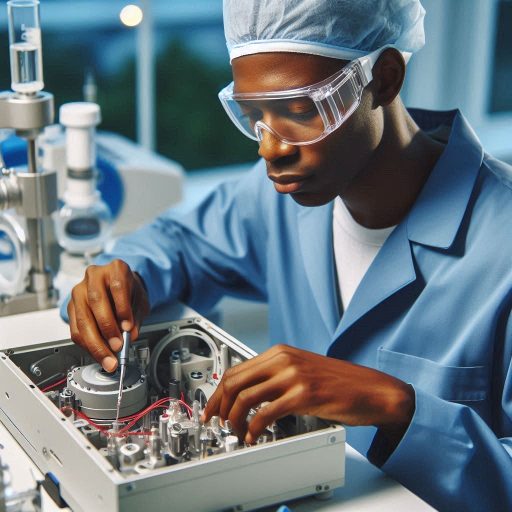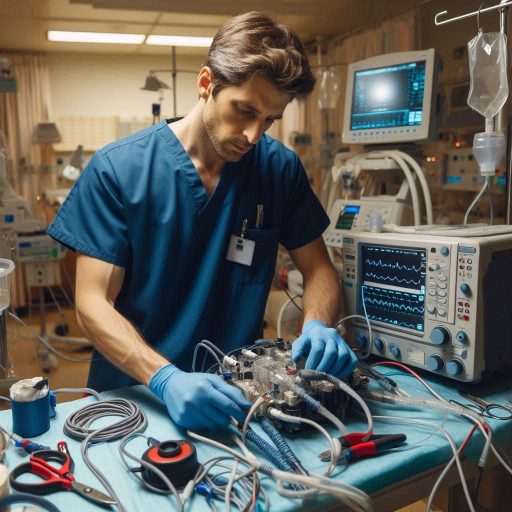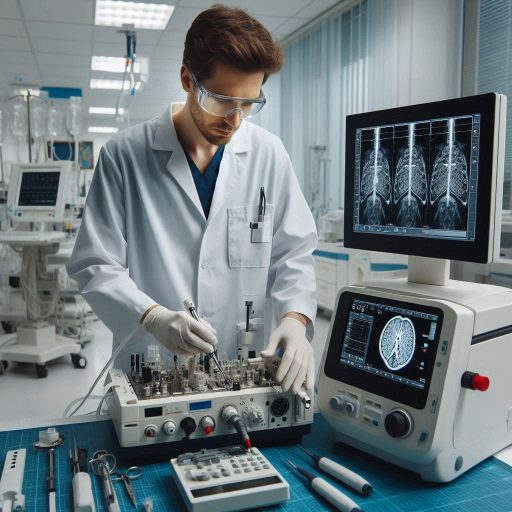Introduction
A Biomedical Equipment Technician (BMET) plays a crucial role in maintaining the functionality and safety of medical devices used in healthcare facilities in Biomedical Equipment Technician Work Environment
Their responsibilities include inspecting, repairing, and calibrating equipment such as ventilators, MRI machines, and infusion pumps.
A well-designed work environment is essential for BMETs to perform their duties effectively.
An organized workspace with clear access to tools and spare parts allows technicians to address issues quickly and minimize equipment downtime.
Additionally, having a clean and safe environment reduces the risk of accidents and enhances productivity.
Support from management and collaborative teamwork further improve the work setting, fostering a culture of continuous learning and problem-solving.
Facilities that invest in updated tools and training resources empower BMETs to stay current with technological advancements.
This blog delves into how the work environment impacts a BMET’s job performance, demonstrating that a supportive and efficient workspace is crucial for optimizing their effectiveness.
Improving these factors not only enhances BMET performance but also contributes to overall patient care and operational efficiency.
Job Duties and Responsibilities
List of typical tasks performed by BMETs in their work environment
Biomedical Equipment Technicians (BMETs) play a crucial role in healthcare facilities.
They ensure medical equipment functions correctly and safely.
Their tasks are varied and often involve complex problem-solving.
BMETs regularly perform equipment inspections, where they check for wear, damage, or malfunctions.
They conduct routine maintenance, which includes cleaning, calibrating, and testing equipment to ensure optimal performance.
When equipment breaks down, BMETs diagnose the problem, replace faulty parts, and restore the device to working order.
They also update software and firmware in computerized devices.
Additionally, BMETs are responsible for keeping detailed records of all inspections, repairs, and maintenance activities.
Another essential duty involves training medical staff on the proper use of equipment.
BMETs provide guidance on how to operate devices safely and efficiently.
They also ensure that all equipment meets regulatory standards and complies with safety protocols.
BMETs often collaborate with manufacturers and suppliers to obtain replacement parts or specialized tools.
They may also assist in the installation of new equipment, ensuring it is set up correctly and integrated into the hospital’s systems.
The Importance of Attention to Detail and Technical Skills
Attention to detail is critical in the work of a BMET.
Even a minor oversight can lead to equipment failure, putting patient lives at risk.
BMETs must be meticulous when inspecting, repairing, and maintaining devices.
Precision is key when calibrating equipment, as inaccurate settings can compromise patient safety.
BMETs also need strong technical skills to troubleshoot complex equipment issues.
They must understand the technical specifications and functionalities of various devices.
This knowledge allows them to identify problems quickly and implement effective solutions.
Technical skills are also vital when updating software and integrating new technology into existing systems.
The Impact of the Work Environment on Task Efficiency
The work environment significantly affects a BMET’s ability to complete tasks efficiently.
A well-organized workspace allows BMETs to find tools and parts quickly, reducing downtime during repairs.
Proper lighting and ventilation also contribute to a comfortable and safe working environment.
In contrast, a cluttered or poorly lit workspace can hinder performance, leading to mistakes or delays.
Access to up-to-date technical manuals and resources is essential for diagnosing and repairing equipment accurately.
Collaboration with other healthcare professionals in a supportive environment fosters knowledge-sharing and problem-solving.
Furthermore, a well-maintained inventory system ensures that necessary parts and tools are readily available.
A positive work environment enhances focus, reduces stress, and allows BMETs to perform their duties with greater precision and efficiency.
Equipment and Tools
Overview of the Equipment and Tools Used by BMETs
Biomedical Equipment Technicians (BMETs) rely on specialized tools to maintain and repair medical equipment.
These devices range from diagnostic machines like MRI scanners to essential life-support systems such as ventilators.
BMETs often use diagnostic software to troubleshoot issues and ensure equipment functions properly.
Tools like multimeters, oscilloscopes, and electrical safety analyzers allow them to assess and repair electrical components accurately.
Calibration tools are crucial for maintaining the precision of medical devices, ensuring they meet strict regulatory standards.
Hand tools are essential for BMETs as they perform routine tasks.
Screwdrivers, wrenches, and pliers help them dismantle, adjust, and reassemble equipment parts.
BMETs also utilize cleaning and sterilization tools to maintain hygiene standards.
Some specialized tools include pressure gauges for monitoring systems and defibrillator analyzers for testing life-saving devices.
Access to a well-stocked toolkit enables BMETs to perform their duties efficiently, minimizing equipment downtime and ensuring patient safety.
Importance of Access to Proper Equipment for Job Performance
Access to the right tools is vital for a BMET’s job performance.
Without proper equipment, BMETs cannot diagnose or repair medical devices accurately.
This lack of resources can lead to extended downtime, affecting patient care.
Proper tools allow BMETs to work quickly and effectively, minimizing disruptions in hospital operations.
Accurate diagnostic tools enable BMETs to pinpoint issues, reducing the time needed for repairs and preventing recurring problems.
Reliable tools also ensure that repairs are done correctly the first time, maintaining the integrity of medical equipment.
Having the right equipment not only improves efficiency but also enhances safety.
Medical devices often involve high voltages and delicate components.
Without the appropriate tools, BMETs may face risks of injury or damage to the equipment.
The availability of specialized tools ensures that BMETs can handle even the most complex devices with precision.
It also allows them to adhere to strict regulatory standards, ensuring that all equipment meets necessary safety requirements.
Impact of the Work Environment on Equipment Maintenance and Availability
The work environment plays a significant role in the maintenance and availability of BMET equipment.
A well-organized workspace ensures that tools are easily accessible, reducing time spent searching for the right equipment.
Proper storage of tools and devices prevents damage, extending their lifespan.
Environmental factors such as temperature, humidity, and cleanliness can affect the performance of diagnostic tools.
BMETs need a controlled environment to ensure accurate calibration and testing.
A supportive work environment also impacts the availability of equipment.
Hospitals and clinics must invest in high-quality tools and provide regular maintenance to keep them in optimal condition.
When BMETs have access to a well-maintained workspace, they can perform their duties more effectively.
This environment allows them to focus on their tasks without unnecessary distractions or delays.
In turn, this leads to improved patient care and a more efficient healthcare system.
Read: Impact of Drones on Surveying and Mapping
Safety Protocols
Importance of Safety Procedures and Protocols for BMETs
Biomedical Equipment Technicians (BMETs) operate in environments where safety is paramount.
They handle sensitive, often life-saving, medical equipment that requires precision and caution.
Strict adherence to safety procedures is essential for protecting both the BMETs and the patients who rely on the equipment.
Neglecting safety protocols can lead to serious accidents, equipment malfunctions, and potential harm to patients.
Safety protocols are the backbone of a BMET’s daily operations.
These protocols are designed to minimize risks associated with handling medical equipment.
For example, grounding techniques are crucial when working with electrical devices to prevent electric shocks.
Regular inspections and maintenance help identify potential hazards before they become critical issues.
BMETs must be vigilant in following these protocols to prevent accidents and injuries, ensuring the equipment remains safe for use.
The Impact of a Safe Work Environment on BMET Performance
A safe work environment is integral to the effective performance of BMETs.
It fosters a culture where safety is prioritized, encouraging technicians to follow protocols without shortcuts.
In a well-organized workspace, tools and equipment are easily accessible, reducing the risk of errors or accidents.
Proper lighting and ventilation also play a role in maintaining a safe environment, reducing the likelihood of mistakes due to fatigue or poor visibility.
The work environment can significantly influence a BMET’s ability to adhere to safety protocols.
In a cluttered or poorly maintained workspace, the likelihood of accidents increases.
For example, improperly stored tools can lead to tripping hazards or accidental damage to equipment.
Conversely, a clean and organized environment supports the BMET’s focus on the task at hand, reducing distractions and enhancing safety compliance.
Work environment can contribute to or detract from adherence to safety protocols
Management plays a crucial role in maintaining a safe work environment for BMETs.
By enforcing safety standards and providing ongoing training, management ensures that BMETs are equipped to handle the challenges of their job safely.
Regular safety audits and feedback sessions help identify areas for improvement, reinforcing the importance of adhering to protocols.
When management is committed to safety, BMETs are more likely to follow suit.
In the field of biomedical equipment technology, safety is non-negotiable.
BMETs must adhere to strict safety protocols to prevent accidents and injuries.
A safe and well-organized work environment not only enhances adherence to these protocols but also ensures the optimal performance of the equipment they maintain.
Management’s role in upholding these safety standards is crucial, as it sets the tone for a culture of safety throughout the organization.
Read: Top Surveying and Mapping Technician Employers
Collaboration with Medical Staff
Importance of Communication and Collaboration with Medical Staff
Effective communication and collaboration between biomedical equipment technicians (BMETs) and medical staff are vital in a hospital setting.
BMETs play a crucial role in maintaining and repairing medical devices, ensuring they operate safely and efficiently.
To do this successfully, clear communication with the medical staff is essential.
Misunderstandings can lead to equipment downtime, affecting patient care and safety.
Therefore, establishing strong communication channels is not just beneficial but necessary.
Medical staff rely heavily on BMETs to resolve technical issues quickly.
A BMET who can communicate effectively can better understand the specific needs of the medical team.
This understanding enables quicker resolution of problems, enhancing the overall efficiency of hospital operations.
Furthermore, when medical staff feel heard and understood, they are more likely to cooperate, creating a smoother workflow.
How the Work Environment Can Facilitate or Hinder Effective Communication
The work environment plays a significant role in facilitating or hindering effective communication between BMETs and medical staff.
A supportive environment encourages open dialogue and fosters trust.
In contrast, a tense or poorly organized environment can lead to communication breakdowns, misunderstandings, and conflicts.
Factors such as physical layout, organizational culture, and leadership style all impact how well BMETs and medical staff can collaborate.
For example, a hospital with well-designed communication channels, such as regular team meetings and a clear reporting structure, can significantly enhance collaboration.
Conversely, a chaotic environment with unclear communication protocols can leave BMETs and medical staff struggling to connect.
This disconnect can result in delayed repairs, frustrated staff, and compromised patient care.
Therefore, it is crucial for hospitals to create an environment that supports clear and consistent communication.
Strategies for Creating a Positive Working Relationship
Creating a positive working relationship between BMETs and medical staff requires intentional strategies.
One effective approach is establishing regular, scheduled meetings between BMETs and key medical personnel.
These meetings provide a platform to discuss ongoing issues, share updates, and address any concerns.
They also help build rapport, making it easier to communicate during high-pressure situations.
Another strategy is encouraging a culture of mutual respect and understanding.
BMETs should educate medical staff on the technical aspects of equipment maintenance, while also learning about the clinical implications of their work.
This mutual knowledge fosters respect and improves communication.
Hospitals can also offer training sessions focused on communication skills, ensuring both BMETs and medical staff are equipped to collaborate effectively.
Lastly, clear and accessible documentation is key.
BMETs should ensure that all maintenance and repair activities are well-documented and easily accessible to medical staff.
This transparency builds trust and reduces the likelihood of miscommunication.
By implementing these strategies, hospitals can create a work environment where BMETs and medical staff collaborate effectively, ultimately enhancing patient care.
Read: Safety Tips for Field Surveying Technicians

Training and Professional Development
Training and Certification for Biomedical Equipment Technicians
Biomedical Equipment Technicians (BMETs) require specialized training to manage complex medical devices effectively.
Most BMETs start with an associate degree in biomedical technology or a related field.
This foundational education covers electronics, anatomy, physiology, and medical terminology.
Hands-on experience through internships is crucial, allowing students to apply their knowledge in real-world settings.
Certifications further enhance a BMET’s qualifications.
The Certified Biomedical Equipment Technician (CBET) is a widely recognized certification.
To earn this, candidates must pass an exam administered by the Association for the Advancement of Medical Instrumentation (AAMI).
The CBET credential demonstrates a BMET’s proficiency and commitment to maintaining high industry standards.
Importance of Ongoing Professional Development
Technology in healthcare is advancing rapidly, making ongoing professional development essential for BMETs.
Staying updated with the latest medical devices, software, and regulations is critical.
Continuous education enables BMETs to provide the best service, ensuring patient safety and device reliability.
Many BMETs pursue advanced certifications, such as the Certified Radiology Equipment Specialist (CRES) or Certified Laboratory Equipment Specialist (CLES).
These certifications allow them to specialize in specific areas, increasing their expertise and value.
Participation in workshops, conferences, and online courses is also vital.
These opportunities provide exposure to the latest advancements and networking with other professionals.
Employers often require BMETs to complete continuing education to maintain certifications.
This requirement ensures that technicians remain proficient and knowledgeable about new technologies and procedures.
Furthermore, professional development fosters career growth, leading to higher positions and better salaries.
Work Environment and Its Impact on Training Opportunities
The work environment plays a significant role in supporting or hindering a BMET’s professional growth.
A supportive work environment encourages training and development by providing access to resources like training programs and tuition reimbursement.
Regular workshops, seminars, and collaboration with other departments can also enhance a BMET’s skills.
Conversely, a work environment that neglects ongoing training can impede a BMET’s growth.
Without access to updated training, technicians may struggle to keep up with new technologies.
This can result in outdated skills, which negatively impacts job performance and patient safety.
Managers and leaders in healthcare organizations must prioritize ongoing training and professional development.
They should allocate time and resources for BMETs to attend training sessions, workshops, and conferences.
Encouraging a culture of continuous learning not only benefits the technician but also enhances the overall quality of care within the organization.
Transform Your Career Today
Unlock a personalized career strategy that drives real results. Get tailored advice and a roadmap designed just for you.
Start NowRead: Recent Trends in Surveying and Mapping Technologies
Stress and Work-life Balance
Potential Stressors in the Work Environment of a Biomedical Equipment Technician
Biomedical Equipment Technicians (BMETs) face unique challenges in their work environment.
They handle critical medical devices, often in high-pressure situations.
These responsibilities can lead to significant stress.
The demand for accuracy, especially when dealing with life-saving equipment, is immense.
Even minor errors can have severe consequences, adding to the pressure.
Time constraints further exacerbate stress.
BMETs often work under tight deadlines, ensuring that equipment is functional and safe for patient use.
Emergency repairs or unexpected breakdowns can occur at any moment, disrupting their planned schedule and adding unexpected stressors.
Additionally, BMETs must stay updated with rapidly evolving technology.
Continuous learning is essential but can be overwhelming.
Keeping pace with advancements while managing day-to-day tasks can lead to burnout if not properly managed.
Importance of Maintaining a Healthy Work-Life Balance
To mitigate stress, maintaining a healthy work-life balance is crucial for BMETs.
A balanced lifestyle is essential for both job satisfaction and overall well-being.
When work consistently intrudes into personal time, it can lead to fatigue, frustration, and ultimately, burnout.
A healthy work-life balance allows BMETs to recharge, reducing the likelihood of chronic stress.
It fosters a positive mindset, which is crucial when handling high-stakes responsibilities.
Moreover, balanced professionals tend to be more productive.
They can approach challenges with fresh energy and a clear mind.
This balance also supports better relationships with colleagues, as it reduces irritability and increases collaboration.
Employers benefit as well when employees maintain a balance.
Satisfied and well-rested employees are less likely to make mistakes, contributing to a safer and more efficient work environment.
Strategies for Managing Stress and Finding Support
BMETs can employ several strategies to manage stress effectively.
First, prioritizing tasks helps in managing workload efficiently.
Identifying critical tasks and focusing on them reduces the pressure of dealing with everything at once.
Second, taking regular breaks is essential.
Short breaks during work allow BMETs to reset and maintain focus, reducing the risk of burnout.
Engaging in physical activity, even brief stretches, can alleviate tension and boost energy levels.
Third, seeking support is crucial.
Building a support network within the workplace can provide an outlet for discussing challenges and sharing solutions.
Peer support helps in realizing that others face similar stressors, which can be reassuring.
Additionally, many workplaces offer mental health resources.
BMETs should take advantage of counseling services, stress management workshops, or employee assistance programs.
These resources provide professional guidance on handling stress and maintaining mental well-being.
Maintaining a balanced approach to work and life, while utilizing effective stress management strategies, ensures that BMETs.
Advancement Opportunities
Overview of Career Advancement Options for BMETs
Biomedical Equipment Technicians (BMETs) have a variety of career advancement opportunities.
Starting as entry-level technicians, they can progress to senior positions.
Advancement often includes roles such as Lead Technician, Biomedical Equipment Supervisor, or even Biomedical Manager.
These positions come with increased responsibilities, higher salaries, and more influence in decision-making.
Certifications and continuous education play a critical role in climbing the career ladder.
Specialized training in areas like imaging equipment or cybersecurity can also open doors to niche, high-demand roles within the industry.
Importance of a Supportive Work Environment in Pursuing Career Goals
A supportive work environment is crucial for BMETs aiming for career growth.
This environment fosters learning, encourages innovation, and values employee contributions.
When BMETs feel supported, they are more likely to take initiative in their work.
They pursue further education, obtain certifications, and develop new skills.
A positive workplace also provides opportunities for mentorship, allowing less experienced BMETs to learn from seasoned professionals.
Managers who actively invest in their team’s growth create a culture where career advancement is not just possible but expected.
How the Work Environment Can Impact Opportunities for Advancement and Growth
The work environment significantly influences a BMET’s ability to advance.
In a well-resourced and supportive setting, BMETs have access to the tools and training necessary for skill development.
Such environments often offer structured career paths, providing clear steps for advancement.
On the contrary, a toxic or unsupportive work environment can hinder career growth.
Lack of resources, poor management, or insufficient training opportunities can stall a BMET’s professional development.
In such environments, even the most dedicated BMETs may struggle to advance, leading to frustration and potentially high turnover rates.
A positive work environment also impacts the opportunities available for BMETs to take on more challenging projects.
Working on complex medical devices or managing larger teams can enhance their skills and make them more competitive for senior roles.
Furthermore, organizations that value their BMETs often involve them in strategic decision-making processes.
This inclusion not only boosts morale but also provides valuable experience that is critical for career advancement.
Conclusion
We delved into the pivotal role of a positive work environment for Biomedical Equipment Technicians.
Such an environment is not just a backdrop but a significant factor influencing their job performance and overall success.
Technicians thrive when they work in settings that promote collaboration, offer clear communication, and provide the necessary tools and resources.
A workplace that values and supports its employees fosters motivation and efficiency, leading to better outcomes in maintaining and repairing critical medical equipment.
Regular feedback and opportunities for professional development are essential components of a supportive work culture.
These elements help technicians stay updated with technological advancements and improve their skills, directly impacting their job satisfaction and effectiveness.
As you reflect on the points discussed, consider how your work environment influences your daily responsibilities and overall performance.
It is crucial to seek out workplaces that emphasize a healthy, supportive atmosphere.
Environments that prioritize employee well-being, encourage continuous learning, and maintain.
Recognizing the importance of a positive work environment can lead to more fulfilling and successful career experiences for Biomedical Equipment Technicians.
[E-Books for Sale]
The Big Book of 500 High-Paying Jobs in America: Unlock Your Earning Potential
$19.99 • 500 High-Paying Jobs • 330 pages
Explore 500 high-paying jobs in America and learn how to boost your career, earn more, and achieve success!
See All 500 High-Paying Jobs of this E-Book
1001 Professions Without a Degree: High-Paying American Jobs You Can Start Now
$19.99 • 1001 Professions Without a Degree • 174 pages
Discover 1001 high-paying jobs without a degree! Unlock career tips, skills, and success strategies for just $19.99!




